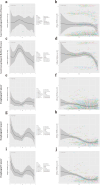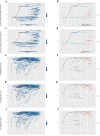Global burden of esophageal diseases: a comprehensive analysis of disease trends and risk factors from 1990 to 2021
- PMID: 40691816
- PMCID: PMC12281767
- DOI: 10.1186/s12876-025-03988-8
Global burden of esophageal diseases: a comprehensive analysis of disease trends and risk factors from 1990 to 2021
Abstract
Background: Esophageal diseases (ED) are a common category of upper gastrointestinal disorders, mainly including gastroesophageal reflux disease (GERD), esophagitis, Barrett's esophagus, achalasia, and esophageal cancer (EC). In recent years, the high recurrence rate of GERD and poor prognosis of EC are paid more attention, collectively contributing to the global burden of ED.
Methods: For this study, we systematically analyzed the global distribution of ED from 1990 to 2021, detailing the burden across different countries, regions, and socio-demographic index (SDI) levels. Furthermore, we explored temporal trends in ED burden over this period and conducted decomposition analysis, health inequality analysis, and frontier analysis. Finally, we projected trends in ED burden from 2022 to 2045, and quantify contributions of associated risk factors to disability-adjusted life years (DALYs) of EC.
Results: The absolute numbers of incidence, mortality, and DALYs for GERD and EC showed increasing trends from 1990 to 2021, while their age-standardized rates (ASRs) demonstrated divergent patterns: stable for GERD and declining for EC. The highest ASRs were observed in low-middle SDI regions for GERD and high-middle SDI regions for EC, respectively, with population as a main driver. If current trends continue, the burden of GERD will continue to rise, whereas that of EC will persistently decline by 2045. In 2021, DALYs of EC were mainly attributed to smoking (36.5%) and alcohol use (16.2%).
Conclusions: For GERD and EC, the global burden continued to rise and decline from 1990 to 2021, respectively. Developing targeted public health strategies in different countries and regions is crucial for alleviating the global burden of ED.
Keywords: Disability-adjusted life years; Esophageal cancer; Gastroesophageal reflux disease; Global burden of diseases; Incidence; Mortality.
© 2025. The Author(s).
Conflict of interest statement
Declarations. Ethics approval and consent to participate: Given that the GBD data is publicly accessible and the analyses involved no identifiable information, ethical approval and participant consent were not required. Consent for publication: Not applicable. Competing interests: The authors declare no competing interests.
Figures









References
-
- GBD 2021 Diseases and Injuries Collaborators. Global incidence, prevalence, years lived with disability (YLDs), disability-adjusted life-years (DALYs), and healthy life expectancy (HALE) for 371 diseases and injuries in 204 countries and territories and 811 subnational locations, 1990-2021: a systematic analysis for the Global Burden of Disease Study 2021. Lancet. 2024;403(10440):2133–61. - PMC - PubMed
-
- Sacco O, Mattioli G, Girosi D, Battistini E, Jasonni V, Rossi GA. Gastroesophageal reflux and its clinical manifestation at gastroenteric and respiratory levels in childhood: physiology, signs and symptoms, diagnosis and treatment. Expert Rev Respir Med. 2007;1(3):391–401. - PubMed
-
- Yang JH, Kang HS, Lee S, et al. Recurrence of gastroesophageal reflux disease correlated with a short dinner-to-bedtime interval. J Gastroenterol Hepatol. 2014;29(4):730–5. - PubMed
MeSH terms
LinkOut - more resources
Full Text Sources
Medical

